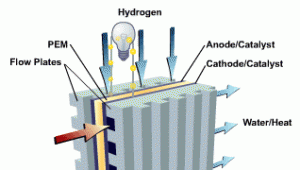 Researchers from Changzhou University, China and Pennsylvania State University, US have reported a ‘remarkable’ novel tin phosphate gel material that performs well in fuel cells, and can also be a fast-charging lithium ion battery anode.
Researchers from Changzhou University, China and Pennsylvania State University, US have reported a ‘remarkable’ novel tin phosphate gel material that performs well in fuel cells, and can also be a fast-charging lithium ion battery anode.
Tin phosphate is a leading candidate for use as a membrane inside intermediate temperature PEM fuel cells (PEMFC), similar to those that power hydrogen cars and buses, as has been shown in recent project involving Nissan. The PEM membrane separates the different reacting zones in the fuel cell that combine hydrogen and oxygen to produce electricity, but must be able to conduct protons between them. According to the new work, tin pyrophosphate is the best proton conductor amongst other layered phosphate alternatives at 100’C. This is important because PEM fuel cells usually operate at lower temperatures but have problems with the water produced in the reaction. At the higher ‘intermediate’ temperature of 100’C the water evaporates but conventional membranes are not suitable.
The new material is produced by a simple environmentally benign process using earth-abundant tin and phosphorus and is potentially highly cost-effective. PEMFC technology is mainly aimed at transport applications, although it can be used in other ways, even for mobile devices. Major automakers such as Toyota are investing heavily in future hydrogen technologies since, although longer term, they can be seen as ultimately the only truly zero emission technology.
The team also found that the new material was remarkably multifunctional. They tested the phosphate gel as a lithium ion battery anode and discovered a fast lithium storage speed of just 13 seconds.
Paper in Chemical Communications, February 2018
Nissan team work on tin pyrophosphate fuel cell membranes, 2015
Wikipedia article on PEM fuel cells
Photo credit: Wikipedia


